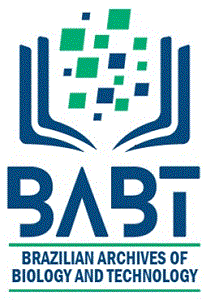HIGHLIGHTS
The semibatch reactor is presented as a new arrangement for fungal bioreactors;
The removal of dye was accompanied by the removal of organic matter in terms of chemical oxygen demand (COD);
The fungi showed high affinity with the polyurethane foam, distributing itself throughout the foam and not restricted only to the surface layer of the support medium;
The fungal community remains dominant through bacterial contamination.
Abstract
The textile industry demonstrates a polluting potential from the planting of cotton to the release of wastewater. The presence of dyes in water bodies decreases the passage of sun rays and directly affects the photosynthetic organisms and the ecosystem. Fungi have potential in the treatment of wastewater containing dyes with complex organic structures due to enzymes that they produce. This study evaluated the use of Phanerochaete chrisosporium in the treatment of synthetic effluent from textile industry containing indigo carmine (20 mg/L). The fungus was immobilized in a semibatch reactor. Glucose was the cosubstrate employed in the experiment and it was used in the system at 1g/L at the beginning of the process and 0.5 g /L after 24 hours of reaction. Average dye removal was 84±10% and chemical oxygen demand removal was 79±14%. For nitrogen compounds, the removal efficiencies were 87±11%, 81±11% and 91±9% for ammonia, nitrite and nitrate, respectively. The pH of the medium remained in the acidic range (2.57 to 5.00) throughout the process, with the lowest values recorded in the effluent of each cycle, justified by the release of organic acids from fungi metabolism. There was contamination of the medium by bacteria (710,000 CFU/mL), but the colonies count showed a predominance of fungi (1,365,000 CFU/mL). With the use of the semibatch system after reading of glucose it was observed that the efficiency of dye removal evolved from 72±17% to 84±10%, producing a final effluent with 3.35±1.99 mg/L of indigo, which proves that treatment configuration analyzed is satisfactory for dye removal.
Keywords:
glucose; indigo carmine; mycoremediation; Phanerochaete chrysosporium; semibatch


 Thumbnail
Thumbnail
 Thumbnail
Thumbnail
 Thumbnail
Thumbnail
 Thumbnail
Thumbnail
 Thumbnail
Thumbnail





